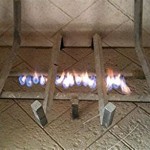Tiled Fireplace Insert: A Fusion of Functionality and Aesthetics
A tiled fireplace insert represents a significant upgrade to a traditional fireplace, combining the efficient heating capabilities of an insert with the decorative appeal of tile. These inserts are designed to slide into an existing fireplace opening, transforming an often inefficient and drafty structure into a powerful and visually appealing heat source. The tile component serves not only as an aesthetic element but also contributes to heat retention and distribution. This article will explore the various aspects of tiled fireplace inserts, including their benefits, design considerations, installation process, and maintenance requirements.
Enhanced Heating Efficiency and Energy Savings
One of the primary advantages of a tiled fireplace insert is its improved heating efficiency compared to a traditional open fireplace. Open fireplaces are notoriously inefficient, with a large portion of the heat generated escaping up the chimney. Fireplace inserts, on the other hand, are designed as closed combustion systems, significantly reducing heat loss. The insert's design forces the fire to burn more completely, extracting more heat from the fuel. This heated air is then circulated into the room, providing a more consistent and comfortable temperature. The tile surround further enhances this efficiency by absorbing and radiating heat long after the fire has died down. This radiant heat contributes to a more stable and even temperature within the room, reducing the reliance on central heating systems and potentially leading to significant energy savings. The use of a blower fan, often incorporated into the insert design, further accelerates the distribution of heated air throughout the room.
The efficiency gains are quantifiable. A traditional open fireplace might have an efficiency rating as low as 10%, meaning that only 10% of the heat produced actually heats the room, while the remaining 90% escapes through the chimney. A modern fireplace insert, particularly those with a tiled surround, can achieve efficiency ratings of 70% or higher. This dramatic improvement translates directly into lower heating bills and a reduced environmental impact, as less fuel is required to achieve the same level of warmth.
Furthermore, many tiled fireplace inserts are designed with features that further optimize heating performance. These features may include adjustable air controls, which allow the user to regulate the intensity of the fire and the rate at which fuel is consumed, and thermostatically controlled blowers, which automatically adjust the fan speed based on the room temperature. These features contribute to a more comfortable and energy-efficient heating experience.
Aesthetic Versatility and Design Integration
Beyond heating efficiency, the aesthetic versatility of tiled fireplace inserts is a major draw for homeowners. Tile offers an unparalleled range of colors, textures, patterns, and styles, allowing for seamless integration into any interior design scheme. Whether the goal is to create a rustic, traditional, contemporary, or minimalist look, tile provides the flexibility to achieve the desired aesthetic. The tile surround can be customized to complement the existing décor, creating a focal point that enhances the overall ambiance of the room.
The selection of tile is a crucial aspect of the design process. Options range from classic ceramic and porcelain tiles to more luxurious materials such as natural stone, glass, and metal. Each material offers its own unique characteristics in terms of appearance, durability, and maintenance requirements. For example, natural stone tiles, such as granite or marble, offer a timeless elegance and exceptional durability but may require periodic sealing to protect against staining. Glass tiles, on the other hand, provide a sleek and modern look and are relatively easy to clean but may be more susceptible to scratching. The choice of tile will depend on the homeowner's personal preferences, budget, and lifestyle.
In addition to the tile material, the choice of tile size, shape, and layout can also significantly impact the overall design. Larger tiles can create a more seamless and contemporary look, while smaller tiles allow for more intricate patterns and designs. The use of accent tiles, such as mosaics or decorative borders, can add visual interest and create a unique focal point. The grout color also plays a crucial role in the overall aesthetic, as it can either blend in with the tile or provide a contrasting effect. The design possibilities are virtually endless, allowing homeowners to create a truly personalized fireplace that reflects their individual style.
The design of the fireplace insert itself also contributes to the overall aesthetic. Many inserts feature glass doors that provide a clear view of the fire, creating a warm and inviting atmosphere. The frame around the glass door can be customized with different finishes, such as black, brass, or nickel, to complement the tile surround and the surrounding décor. Some inserts also feature decorative accents, such as cast iron detailing or etched glass, which add to their visual appeal.
Installation Considerations and Safety Standards
The installation of a tiled fireplace insert is a complex process that requires careful planning and adherence to safety standards. It is highly recommended that the installation be performed by a qualified professional with experience in fireplace insert installations. The installation process typically involves the following steps: inspection of the existing fireplace, preparation of the fireplace opening, installation of the insert and flue liner, and finishing the tile surround.
Before installing the insert, the existing fireplace must be thoroughly inspected to ensure that it is structurally sound and meets all applicable building codes. The chimney must be cleaned and inspected for any cracks or damage. In many cases, it will be necessary to install a new flue liner to ensure proper venting of the exhaust gases. The flue liner should be sized appropriately for the insert and should be made of a material that is compatible with the type of fuel being burned. The preparation of the fireplace opening may involve removing existing masonry or adjusting the size of the opening to accommodate the insert.
The insert itself is typically installed by sliding it into the prepared fireplace opening and connecting it to the flue liner. The insert must be properly sealed to prevent air leaks and ensure efficient combustion. The tile surround is then installed around the insert, creating a finished and aesthetically pleasing appearance. The tile surround must be installed in accordance with the manufacturer's instructions and should be properly grouted and sealed to protect against moisture damage.
Safety is paramount during the installation process. It is essential to follow all manufacturer's instructions and to comply with all applicable building codes and safety regulations. The insert must be properly grounded to prevent electrical shock. A carbon monoxide detector should be installed in the room to alert occupants to the presence of dangerous levels of carbon monoxide. The fireplace insert should be inspected and maintained regularly to ensure that it is operating safely and efficiently.
After the installation is complete, it is important to educate the homeowner on the proper operation and maintenance of the fireplace insert. This includes instructions on how to start and maintain a fire, how to adjust the air controls, and how to clean the insert and the tile surround. Regular maintenance, such as cleaning the chimney and inspecting the flue liner, is essential to ensure the long-term safety and efficiency of the fireplace insert.
Choosing the right professional for the installation is key. Verify their licenses, insurance and experience. Request references and check online reviews. A qualified installer will not only ensure a safe and efficient installation but can also advise on the best type of insert and tile for a specific application and budget.
The cost of a tiled fireplace insert can vary depending on several factors, including the size and type of insert, the type of tile used, and the complexity of the installation. It is important to obtain multiple quotes from qualified installers and to carefully consider all costs before making a decision. While the initial investment may be significant, the long-term energy savings and aesthetic benefits of a tiled fireplace insert can make it a worthwhile investment for many homeowners.

Gallery Sovereign Cast Iron Tiled Fireplace Insert Flames Co

Sovereign Tiled Insert Fireplace Cast Fireplaces

Gallery Tulip Cast Iron Tiled Fireplace Insert Flames Co

Voysey Tiled Fireplace Insert Twentieth Century Fireplaces

Victorian Tiled Fireplace Insert 3035ti Antique Co

Victorian Tiled Fireplace Insert 4403ti Antique Co

Hampstead Tiled Fireplace Insert Edwardian Fireplaces

Gallery Collection Prince Tiled Cast Iron Insert From Direct Fireplaces

Tiles For Fireplace Inserts In London Wimbledon Enviro Flame

Prince Tiled Insert Fireplace Cast Fireplaces
Related Posts








